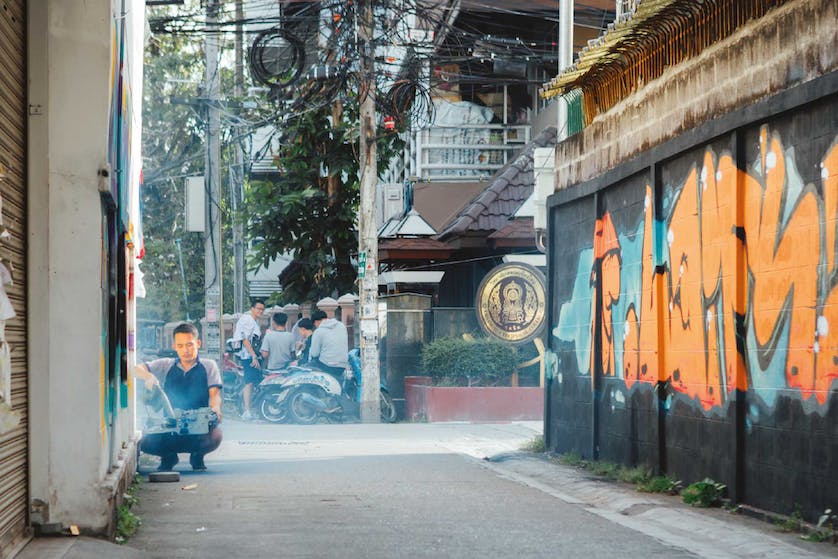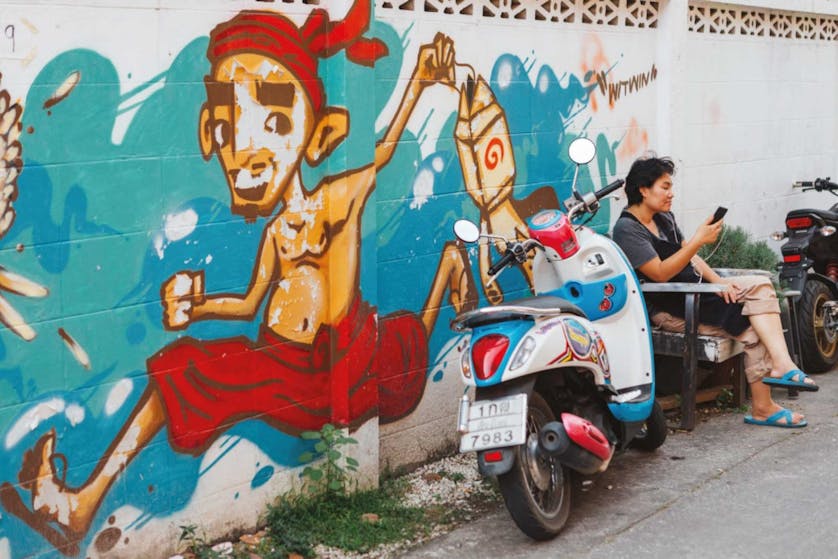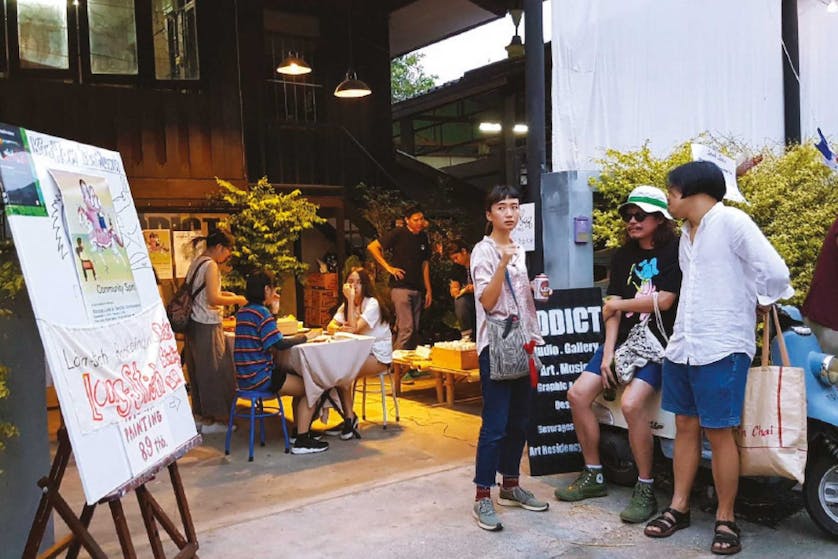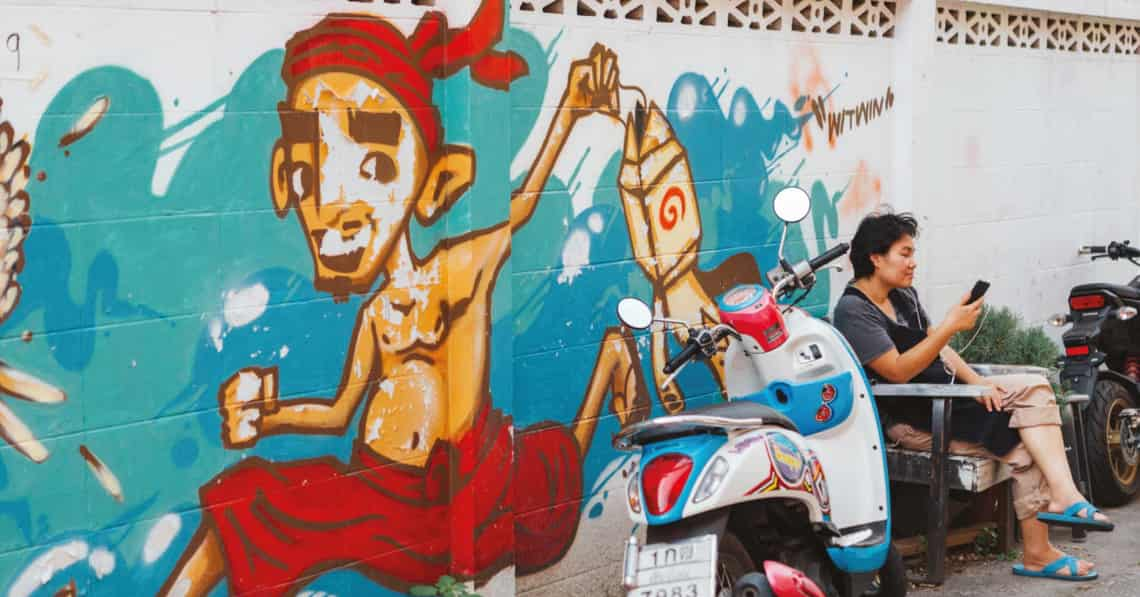“We have nothing left from the old times,” said Srichai Taisiri, or Auntie Tai, of the small Kuan Khama Community, going on to compare her neighbourhood with other areas in the old city such as Puak Taem on the south side of the old city known for its craftsmanship and the famed silversmiths of Wualai community near Chiang Mai Gate.


Gathering a Community
It wasn’t until 1999 that the official Kuan Khama Community was established. “I had noticed that friends in other neighbourhoods were receiving gifts from officials — shirts, blankets, toys for children’s day. I asked why I didn’t get these things and they said, “Because you aren’t a community!” That was when Auntie Air began exploring how to institute a community. It wasn’t long before she managed to recruit 15 members to form a committee, finding herself its leader. However, the hard bit was not establishing it, but running it. She then spent the next three years learning what her role was by attending all the meetings government officials summoned her to. “I can’t really write so I memorise everything and then spread the word,” said Auntie Air. She then started to participate in government-driven projects such as forming the Community Massage Group, forming the Village Health Volunteer (VHV) group, and the Women’s Group. She describes VHV as being a ‘serf for doctors’ – from taking care of bedridden patients to finding water sources where mosquitos breed. Auntie Air went on to say it’s usually the same people doing the work as the younger generation had little interest in participating in community activities. “We live like brothers and sisters. We keep those who are too sick or old to work on the VHV committee so that they can still earn some money,” she said of the 600 baht a month stipend. “The support from government isn’t consistent; it comes and goes,” she continued, explaining that her attention is now focused on a young newbie to the community, an art space called Addict Art Studio, run by a Bangkok man who goes by the name CAS, who moved here eight years ago. Addict Art Studio opened in 2017 and appears to have become an integral part of the community, bringing in fresh new ideas and activities that gets Auntie Air quite excited. Through the launch of the Spark U project, CAS has involved the community in promoting their lifestyle and culture, holding activities such as Lanna Storytelling: Colour of Khuan Khama Community’s Tourism having the former governor opened the activity. “This boy, he lives here so I can be assured that his projects are not going anywhere soon,” said Auntie who has developed a bond with CAS.
Fresh Blood
Getting to Addict Studio is like following a trail of graffiti. The studio is a simple two storey wooden house in a small soi off Sri Phum Road surrounded by street art painted on almost every available wall — CAS insists that he always asks permission first. And just across the street is Auntie Tai’s house where many young artists and art lovers seeking graffiti gems sometimes wander into, even at times asking Auntie Tai to cook a simple dish for them. The gates between Auntie Tai and CAS are rarely closed during the day. As we were chatting to the aunties in Auntie’s Tai shady front yard, CAS popped in. “We want to drive this community to weave their own culture into a blend of old traditions and modern art,” said CAS who is in his early 30s. CAS said that he knew no one when he first moved to Chiang Mai, but by reaching out to Thai and international street artists, as well as getting to know his neighbours, he now feels part of a community. Not Everyone’s a Fan “I don’t know what to say. Maybe their parents didn’t teach them well,” sighed the 77 year old abbot in disapproval of CAS and his ilk. “Fewer and fewer people are practicing our old traditions. The young kids are not taught to respect our culture. They can’t even speak kam muang (northern dialect) these days. Only 10 local households regularly visit the temple,” he added sadly.

New Mission New Vision
“In the old days, there were ‘temple servants’ who would do voluntary work for the temples as an act of merit,” said Asst. Prof. Komson Teerapapwong, Faculty of Architecture, Chiang Mai University, who is working on the UNESCO Chiang Mai World Heritage Project. The aim is to propel Chiang Mai, especially the old city, to be listed as a World Heritage Site, which we have been on the tentative list of since 2014. “There used to be ‘ban kao’ where the eldest would inherit the house from their parents and great grandparents. The house would contain the shrine of the spirits of their ancestors,” explained Asst. Prof. Komson. “This is where family would gather on all important occasions, the house connecting the generations and giving them a sense of home. Now the bond between the house, the community and the temple has been lost. Today, people tend to buy new homes and move to the suburbs. Old houses are either empty or sold off,” he added. He went on to say that properties in the old city were being sold and resold at an alarming rate, “Since the price today is around 200,000 baht per sq. wah, why would an elderly couple living on 100 sq. wah not wish to sell? It’s big money,” he said, adding that finding ways to convince locals to remain in their traditional communities is one of the many challenges of the Chiang Mai World Heritage Project team. “The UNESCO project team needs to hold regular meetings with the community and keep us informed and excited about this,” said Auntie Air, adding that she told them that the important thing was an allowance! “50 baht each for their time is about right and they have to also provide snacks or lunch. You’ve got to serve them on the spot though, because once they leave their seats they are gone,” she explained bluntly and rather cynically while admitting that if widely supported, the project could have a positive impact on the community. “To succeed, we need local participation,” explained Asst. Prof. Komson. “Unlike Sukhothai, where historical ruins are preserved, we are proposing a living museum where you can have things like modern art movements as long as they interact with the heritage. There should be opportunity for culture to grow and develop, but the balancing act is the tricky part.”
The Future is Bright
“It’s good fun with CAS around,” said auntie Tai, whose walls have been painted and repainted over and over again by visiting street artists as well as by CAS who uses them to practices his skills. While some members of the community frown on such non-Lanna art and culture, it appears that others are embracing the future. Last year, the studio held the Kinhom Tommuan Art Fest, closing the street in front of Auntie Tai’s house and inviting local aunties and grannies to get involved. Turning out in their prettiest pasin, the ladies took to the catwalk in a fashion show, sold their home made music and danced to hip hop. The fair inspired Auntie Tai to open a restaurant in her yard and Auntie Air to plan to launch weekly mini-fairs. As we chatted, a camera-toting tourist walked by and asked where the Polar Bear graffiti was, and thanks to directions from the aunties, headed off. “This has happened several times,” said CAS smilingly. “I appreciate the energy and passion he has brought with him,” said Auntie Air of CAS. “I know we are a small community but I can’t help but feel proud when there are people out there talking about and wanting to come visit us.”
